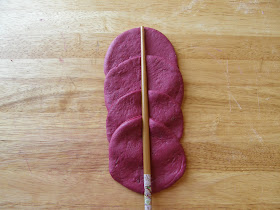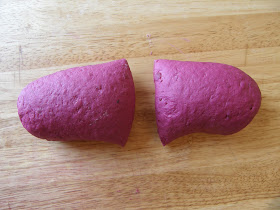
Moon cakes come in all kinds of flavors, but traditionally they have a red bean filling with a dried egg yolk in the middle which is supposed to resemble a moon in the dark sky. Usually they come in fancy packages and people give them to each other as gifts during the holiday. While the traditional moon cakes are pretty and festive, they’re kind of like Christmas fruitcakes — no one actually eats them. That’s why I make mine extra flaky with a coconut filling. They’re not only pretty, but also very delicious and fun to make!
You will need:
Ingredients:
Yields 24 golf ball size cakes
Dough A:
1 1/2 cup all purpose flour
1 Tbsp granulated sugar
1/3 cup vegetable oil
1/3 cup hot water
Dough B:
1 1/4 cup cake flour
1/3 cup vegetable oil
1 T salted butter (room temperature)
Fillings:
1/2 cup confectioners sugar
1 1/2 Tbsp granulated sugar
4 T salted butter (room temperature)
1 egg
1 cup unsweetened shredded coconut
4 Tbsp milk powder
1 egg for egg wash
Directions:
Started by making the fillings. Cream the butter and sugar until light and fluffy. Beat in the eggs and mix in the shredded coconut and milk power until combined. Chill in the refrigerator for at least 30 minutes for it to set and firm up.
Meanwhile, make the dough. Preheat your oven to 375F. You will be
working with two different doughs for the pastry. Start by mixing all of
the ingredients from Dough A. Try not to work the dough too much. Like a
pie crust, the less you work with it, the flakier the pastry will be.
Once the dough comes together, cover it up and let it sit at room
temperature for 20 minutes.
Do the same with dough B. Combine the ingredients and let it rest for 20 minutes.
After both the doughs have rested for 20 minutes, roll into two separate logs. Then cut each into 24 pieces.
Roll them into ball shapes. Then cover them up and let them sit for 10 minutes.
After 10 minutes, roll each dough A into flat disks. Then place each ball of dough B in the center of dough A. Wrap dough B up tightly. Cover them up and let the dough rest for another 10 minutes.
Now press the middle of the dough gently and fold the two sides into the center. Very gently form the dough into a ball again. Cover them up. Meanwhile we can work on the coconut fillings.
Roll the chilled coconut fillings into 24 individual balls.
Roll the dough into disks and place the coconut fillings in the center and wrap it up tightly.
Keep the cakes in an air tight container at room temperature. They should be able to keep for up to a month, but they are very addictive you may not last for that long. You will be surprised at how flaky the pastry is. Serve it with a cup of tea while enjoying the full moon weekend with your family and friends.
Sponsored by The Free Press
http://www.freepressonline.com/






















































